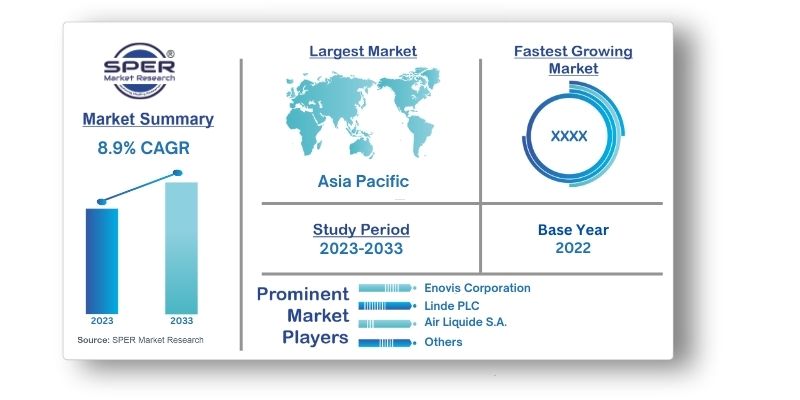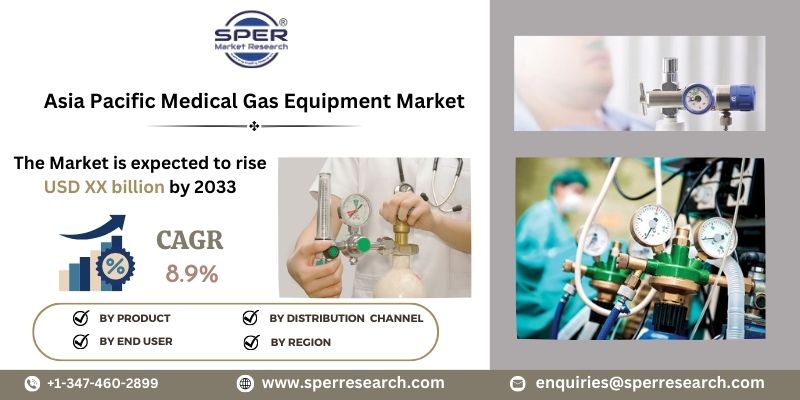
Asia Pacific Medical Gas Equipment Market Growth, Size, Trends, Revenue and Future Outlook
Asia Pacific Medical Gas Equipment Market Size- By Product, By End Use– Regional Outlook, Competitive Strategies and Segment Forecast to 2033
| Published: May-2023 | Report ID: MEDE2315 | Pages: 1 - 157 | Formats*: |
| Category : Medical Devices | |||


| Report Metric | Details |
| Market size available for years | 2019-2033 |
| Base year considered | 2022 |
| Forecast period | 2023-2033 |
| Segments covered | By Product, By End Use |
| Regions covered | Australia, China, India, Indonesia, Japan, Malaysia, Philippines, Singapore, South Korea, Thailand, Vietnam, Rest of Asia-Pacific |
| Companies Covered | Air Liquide S.A., Allied Healthcare Products, Inc., Amico Group of Companies, Atlas Copco AB, Drägerwerk AG & Co. KGaA, Enovis Corporation, GCE Holding AB (ESAB Corporation), Genstar Technologies Company Inc., GENTEC (Shanghai) Corporation, Linde PLC, Powerex, Rotarex S.A., Taiyo Nippon Sanso Corporation, Others. |
- Government and Regulatory Authorities
- Healthcare Investors and Venture Capitalists
- Healthcare Professionals
- Hospitals and Clinics
- Medical Gas Associations and Industry Groups
- Medical Gas Consultants
- Medical Gas Equipment Maintenance and Service Providers
- Medical Gas Manufacturers and Suppliers
- Research and Academic Institutions
- Asia Pacific Medical Gas Equipment Market Value Share and Forecast, By Product, 2023-2033
- Alarm Systems
- Cylinders & Accessories
- Flowmeters
- Hose Assemblies & Valves
- Manifolds
- Masks
- Medical Air Compressors
- Outlets
- Regulators
- Vacuum Systems/Pumps
- Asia Pacific Medical Gas Equipment Market Value Share and Forecast, By End Use, 2023-2033
- Academic & Research Institutions
- Ambulatory Surgical Centers
- Diagnostic & Research Laboratories
- Home Healthcare
- Hospitals
- Pharmaceutical & Biotechnology Companies
- Australia
- China
- India
- Indonesia
- Japan
- Malaysia
- Philippines
- Singapore
- South Korea
- Thailand
- Vietnam
- Rest of Asia-Pacific
- Asia Pacific Medical Gas Equipment Market Size (FY’2023-FY’2033)
- Outline of Asia Pacific Medical Gas Equipment Market
- Segmentation of Asia Pacific Medical Gas Equipment Market By Product (Alarm Systems, Cylinders & Accessories, Flowmeters, Hose Assemblies & Valves, Manifolds, Masks, Medical Air Compressors, Outlets, Regulators, Vacuum Systems/Pumps)
- Segmentation of Asia Pacific Medical Gas Equipment Market By End Use (Academic & Research Institutions, Ambulatory Surgical Centers, Diagnostic & Research Laboratories, Home Healthcare, Hospitals, Pharmaceutical & Biotechnology Companies)
- Statistical view of Asia Pacific Medical Gas Equipment Market
- Analysis of the Growth of Asia Pacific Medical Gas Equipment Market
- Obstacles and Challenges in Asia Pacific Medical Gas Equipment Market
- Competitive Environment in the Asia Pacific Medical Gas Equipment Market
- Effect of COVID-19 on Asia Pacific Medical Gas Equipment Market
- Details on New Investment in Asia Pacific Medical Gas Equipment Market
- Competitive Analysis of Asia Pacific Medical Gas Equipment Market
- Key Participants in the Asia Pacific Medical Gas Equipment Market
- SWOT Analysis of Asia Pacific Medical Gas Equipment Market
- Asia Pacific Medical Gas Equipment Market Projected Outlook and Future (FY’2023-FY’2033)
- Recommendations from Analyst
1.1. Scope of the report1.2. Market segment analysis
2.1. Research data source
2.1.1. Secondary Data2.1.2. Primary Data2.1.3. SPER’s internal database2.1.4. Premium insight from KOL’s
2.2. Market size estimation
2.2.1. Top-down and Bottom-up approach
2.3. Data triangulation
4.1. Driver, Restraint, Opportunity and Challenges analysis
4.1.1. Drivers4.1.2. Restraints4.1.3. Opportunities4.1.4. Challenges
4.2. COVID-19 Impacts of the Asia Pacific Medical Gas Equipment Market
5.1. SWOT Analysis
5.1.1. Strengths5.1.2. Weaknesses5.1.3. Opportunities5.1.4. Threats
5.2. PESTEL Analysis
5.2.1. Political Landscape5.2.2. Economic Landscape5.2.3. Social Landscape5.2.4. Technological Landscape5.2.5. Environmental Landscape5.2.6. Legal Landscape
5.3. PORTER’s Five Forces
5.3.1. Bargaining power of suppliers5.3.2. Bargaining power of buyers5.3.3. Threat of Substitute5.3.4. Threat of new entrant5.3.5. Competitive rivalry
5.4. Heat Map Analysis
6.1. Asia Pacific Medical Gas Equipment Market Manufacturing Base Distribution, Sales Area, Product Type6.2. Mergers & Acquisitions, Partnerships, Product Launch, and Collaboration in Asia Pacific Medical Gas Equipment Market
7.1. Asia Pacific Medical Gas Equipment Market Value Share and Forecast, By Product, 2023-20337.2. Alarm Systems7.3. Cylinders & Accessories7.4. Flowmeters7.5. Hose Assemblies & Valves7.6. Manifolds7.7. Masks7.8. Medical Air Compressors7.9. Outlets7.10. Regulators7.11. Vacuum Systems/Pumps
8.1. Asia Pacific Medical Gas Equipment Market Value Share and Forecast, By End Use, 2023-20338.2. Academic & Research Institutions8.3. Ambulatory Surgical Centers8.4. Diagnostic & Research Laboratories8.5. Home Healthcare8.6. Hospitals8.7. Pharmaceutical & Biotechnology Companies
9.1. Asia Pacific Medical Gas Equipment Market Size and Market Share
10.1. Asia Pacific Medical Gas Equipment Market Size and Market Share By Product (2019-2026)10.2. Asia Pacific Medical Gas Equipment Market Size and Market Share By Product (2027-2033)
11.1. Asia Pacific Medical Gas Equipment Market Size and Market Share By End Use (2019-2026)11.2. Asia Pacific Medical Gas Equipment Market Size and Market Share By End Use (2027-2033)
12.1. Asia Pacific Medical Gas Equipment Market Size and Market Share By Region (2019-2026)12.2. Asia Pacific Medical Gas Equipment Market Size and Market Share By Region (2027-2033)12.3. Australia12.4. China12.5. India12.6. Indonesia12.7. Japan12.8. Malaysia12.9. Philippines12.10. Singapore12.11. South Korea12.12. Thailand12.13. Vietnam12.14. Rest of Asia-Pacific
13.1. Air Liquide S.A.
13.1.1. Company details13.1.2. Financial outlook13.1.3. Product summary13.1.4. Recent developments
13.2. Allied Healthcare Products, Inc.
13.2.1. Company details13.2.2. Financial outlook13.2.3. Product summary13.2.4. Recent developments
13.3. Amico Group of Companies
13.3.1. Company details13.3.2. Financial outlook13.3.3. Product summary13.3.4. Recent developments
13.4. Atlas Copco AB
13.4.1. Company details13.4.2. Financial outlook13.4.3. Product summary13.4.4. Recent developments
13.5. Drägerwerk AG & Co. KGaA
13.5.1. Company details13.5.2. Financial outlook13.5.3. Product summary13.5.4. Recent developments
13.6. Enovis Corporation
13.6.1. Company details13.6.2. Financial outlook13.6.3. Product summary13.6.4. Recent developments
13.7. GCE Holding AB (ESAB Corporation)
13.7.1. Company details13.7.2. Financial outlook13.7.3. Product summary13.7.4. Recent developments
13.8. Genstar Technologies Company Inc.
13.8.1. Company details13.8.2. Financial outlook13.8.3. Product summary13.8.4. Recent developments
13.9. GENTEC (Shanghai) Corporation
13.9.1. Company details13.9.2. Financial outlook13.9.3. Product summary13.9.4. Recent developments
13.10. Linde PLC
13.10.1. Company details13.10.2. Financial outlook13.10.3. Product summary13.10.4. Recent developments
13.11. Powerex
13.11.1. Company details13.11.2. Financial outlook13.11.3. Product summary13.11.4. Recent developments
13.12. Rotarex S.A.
13.12.1. Company details13.12.2. Financial outlook13.12.3. Product summary13.12.4. Recent developments
13.13. Taiyo Nippon Sanso Corporation
13.13.1. Company details13.13.2. Financial outlook13.13.3. Product summary13.13.4. Recent developments
13.14. Others
SPER Market Research’s methodology uses great emphasis on primary research to ensure that the market intelligence insights are up to date, reliable and accurate. Primary interviews are done with players involved in each phase of a supply chain to analyze the market forecasting. The secondary research method is used to help you fully understand how the future markets and the spending patterns look likes.
The report is based on in-depth qualitative and quantitative analysis of the Product Market. The quantitative analysis involves the application of various projection and sampling techniques. The qualitative analysis involves primary interviews, surveys, and vendor briefings. The data gathered as a result of these processes are validated through experts opinion. Our research methodology entails an ideal mixture of primary and secondary initiatives.



Frequently Asked Questions About This Report
PLACE AN ORDER
Year End Discount
Sample Report
Pre-Purchase Inquiry
NEED CUSTOMIZATION?
Request CustomizationCALL OR EMAIL US
100% Secure Payment






Related Reports
Our Global Clients
Our data-driven insights have influenced the strategy of 200+ reputed companies across the globe.




















